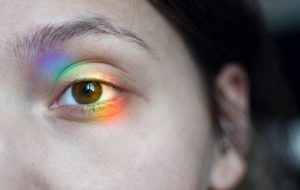-
See the Difference: Save $1,000 on LASIK , Find More
*Must mention this promotion and be treated in October of 2024 to qualify. $1,000 off for both eyes on standard Wavelight price, $500 off for one eye. Cannot be combined with any other offers.
What is a Scotoma?

As humans we rely on our eyesight for basically every aspect of our day-to-day life. So when something affects your ability to see, it’s natural to worry. Don’t! Our team is here to help.
Today we’re covering everything you need to know about scotomas, a common eye complication that affects your vision. If you’re interested in learning more about this common eye complication, keep scrolling…
What is a Scotoma?
Commonly mistaken as eye floaters, scotomas (pronounced skuh-TOE-muhs) are an “aura” or blind spot that blocks part of your vision. This vision impairment can appear in the form of a dark spot, or a flicker of light/dark, and it can be either permanent or temporary- depending on what caused your scotoma in the first place.
Sometimes it can be the sign of an underlying health issue, so it’s very important that you take this (or any sudden change in your vision) seriously.
What Causes Scotomas?
There are many things that can cause scotomas- from a bad headache to a stroke. Here are a few of the most common causes of scotomas:
- Strokes
- Brain injury
- Glaucoma
- Inflammation
- Macular degeneration
- High blood pressure
- Stress
- Anxiety
- Depression
- Pregnancy
- Food Allergies
- Migraines
- retinitis pigmentosa– a super-rare genetic disorder.
What are the Different Types of Scotomas?
There are a few different types of scotomas, categorized by their appearance and where they appear in your vision. Here are the main types of scotomas:
Scintillating Scotoma
Scintillating (meaning “sparkling” or “shimmering”) scotomas are a visual disturbance occuring in your off-center or peripheral vision.
Unlike other scotomas, this type of blind spot tends to move around instead of staying in one place. These are usually arc-shaped or ring-shaped, may have either wavy or jagged edges, and can be multi-colored or switch between light and dark colors.
They are commonly associated with migraines which is why they’re sometimes referred to as a migraine scotoma- though a scintillating scotoma can occur without a headache, as well. A scintillating scotoma is usually temporary and can last for either a few seconds or a few hours, depending on the severity of your headache.
Other than migraines, scintillating scotomas can also be caused by:
- Stress
- Hormone changes
- Hypertension and high blood pressure
- Severe head injury
- Multiple Sclerosis
- Strokes
- Preeclampsia (a pregnancy complication)
Paracentral Scotoma
A paracentral scotoma is a blind spot slightly off-center in your vision.
For example, if you have a paracentral scotoma, you can probably see the words on road signs clearly, but there are spots near the sign that are dark or blurry. The main causes of paracentral scotomas are glaucoma and diabetic retinopathy, and oftentimes this type of scotoma is accompanied by peripheral vision loss as well.
Central Scotoma
Aptly named, this type of scotoma appears in the direct center of your vision.
Central scotomas are one of the more devastating visual impairments because they can make everything from reading road signs to recognizing faces challenging- even impossible. A central scotoma can be caused by a stroke, infection, macular degeneration, diabetic retinopathy, diabetic macular edema, a tumor, or brain injury.
How to Treat a Scotoma
When it comes to treating scotomas, your options will vary depending on the type of blurry vision that you’re experiencing.
Scintillating scotomas resulting from a migraine usually disappear (without any treatment) in less than an hour. You can also take a nap, drink a glass of water, or take an over-the-counter pain reliever, such as ibuprofen or acetaminophen to help reduce the symptoms that relieve your migraine while you wait for the blind spot to go away.
If a scotoma is appearing due to high blood pressure, stress, or other health conditions, there are specific treatments for those to help prevent blind spots in the future. Your doctor might recommend a beta-blocker to help relax your blood vessels, an antidepressant to help even-out your serotonin levels and lower your chances of getting a migraine, or an anti-epileptic medication to help with any neurological issues.
Talk to your doctor right away if you’re experiencing any vision changes- even if they’re not completely impeding your vision!

When to See a Doctor About Your Scotoma
Losing parts of your eyesight can create headaches in your daily life, impacting your overall health and wellbeing, so we always advise checking in with your eye doctor as soon as you start noticing a difference in your vision. To diagnose a scotoma your doctor will do a visual test and a dilated eye exam.
Occasionally, additional testing may be needed to provide a definitive diagnosis.
In some instances, a scotoma accompanied by certain symptoms is the sign of a more serious health condition, and should be addressed as soon as possible. Seek medical attention immediately if you have a scotoma and are experiencing any of the following :
- A severe headache or migraine
- Weakened muscles
- Trouble speaking or slurring your speech
- Confusion or disorientation
- Nausea or dizziness
- Numbness in your face, arms or legs
We also recommend that you schedule a yearly eye exam to be proactive about scotomas and other vision challenges before they become a real issue- especially if you have diabetes, high blood pressure, or a cardiovascular disease.
Shining a Light on Your Vision Impairment
We get it: vision disturbances can totally alter your way of life. However, these are usually benign, so they’ll come and go without much cause for alarm. If they don’t, simply talk to your eye doctor to see which course of action is best for you.
YOU MIGHT ALSO LIKE...
VISION CENTERS NEAR ME
Enter your zip code, city, or a doctor name below to find a vision center.
Find out if LASIK is right for you
Congratulations!
Your vision issues can most likely be corrected with a LASIK procedure. Schedule a free consultation today.
Answer 5 simple questions to see if you are a candidate
What is your age group?
Do you wear...
With corrective lenses, do you have...
Have you ever been told that you have astigmatism?
Have you ever been told that you have dry eyes?
Request an Information Kit
Learn about your surgeon, the latest advanced technology, procedures, options and benefits, financing options, and what to expect from your LASIKPlus experience.









